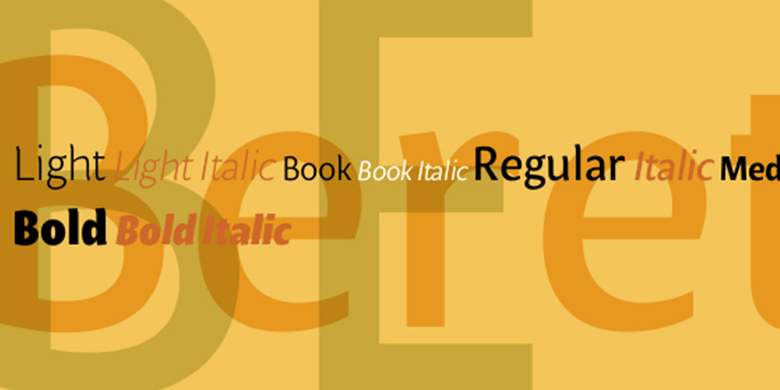字体介绍
品牌:Linotype(Monotype)设计师:Omine,Eduardo发行时间:2020字库编码:Unicode分类:无衬线体字体属性:
英文名称:zhuan_BeretLTStd-Light.TTF、zhuan_BeretLTStd-LightItalic.TTF、zhuan_BeretLTStd-Medium.TTF、zhuan_BeretLTStd-MediumItalic.TTF、zhuan_BeretLTStd-Book.TTF、zhuan_BeretLTStd-BoldItalic.TTF

巴西设计师Eduardo Omine设计了他的Beret家族字体,试图创作出一种温暖的字体,与20世纪简洁、极简的无衬线字体形成对比。Beret最具个性的特点是垂直的笔触末端。它们轻微弯曲,模拟一种微妙的闪光。像许多经典的无衬线字体(例如,原来的Syntax和Univers),这个家族不包括真正的(书法)斜体。而是创建了一组精巧的斜角。正如Stanley Morison在20世纪20年代和30年代早期所阐述的那样,当人们想要强调文本中的某些单词或段落时,这些“罗马”风格的斜体可能会更有效。
Beret家族的字体适合于许多应用,在文本和显示的不同大小上。以下九种字体组成了Beret的设计:Beret Light、Beret Light Italic、Beret Book、Beret Book Italic、Beret Regular、Beret Medium, Beret Medium Italic、Beret Bold和Beret Bold Italic。Beret在2003年由Linotype GmbH主办的国际字体设计大赛中获得了荣誉奖。
Brazilian designer Eduardo Omine designed his Beret family of typefaces in an attempt to create a warm counterpart to the clean, minimalist sans serif of the 20th Century. The most individual characteristics of Beret are the terminals at the ends of its vertical strokes. They are slightly bent", simulating a subtle flare. Like many classic sans-serif typefaces (e.g., the original Syntax and Univers), this family does not include true (calligraphic) italics. Instead, a masterful set of obliques has been created. As Stanley Morison articulated in the early 1920s and 30s, these slanted versions of the regular "roman" faces may even work better when one wishes to emphasize certain words or passages within a text.
The Beret family of typefaces is suitable for numerous applications, in both text and display sizes. The following nine fonts make up the family’s design: Beret Light, Beret Light Italic, Beret Book, Beret Book Italic, Beret Regular, Beret Medium, Beret Medium Italic, Beret Bold, and Beret Bold Italic. Beret was awarded an Honorable Mention in the 2003 International Type Design Contest, sponsored by the Linotype GmbH."

评论(0)